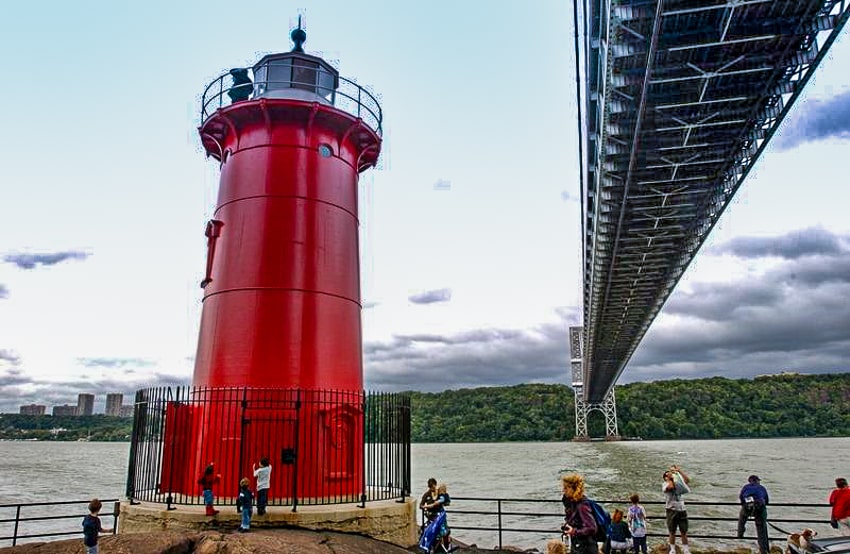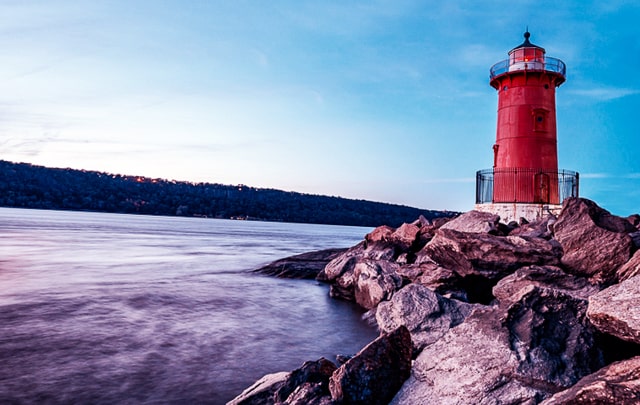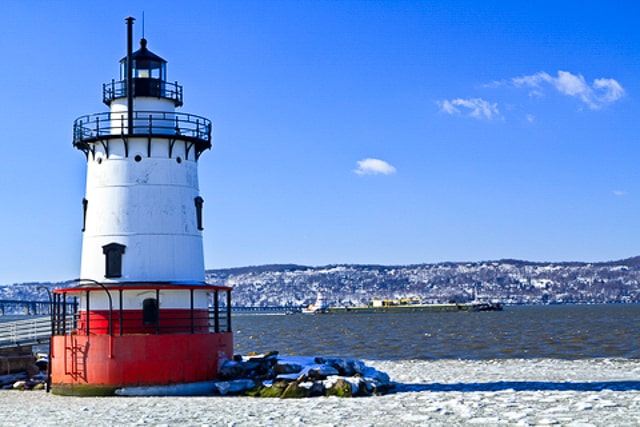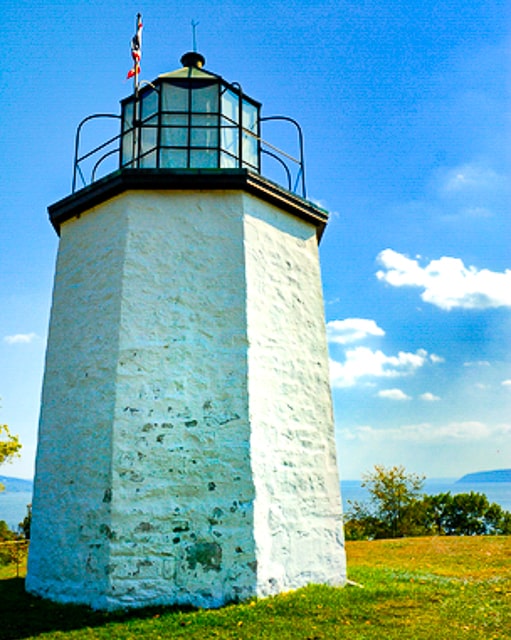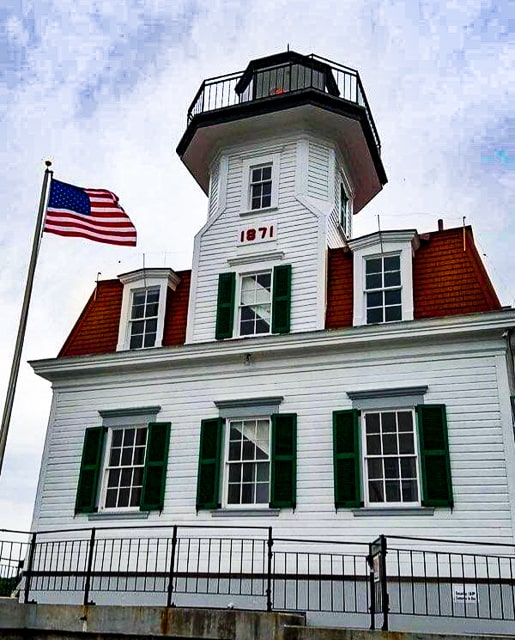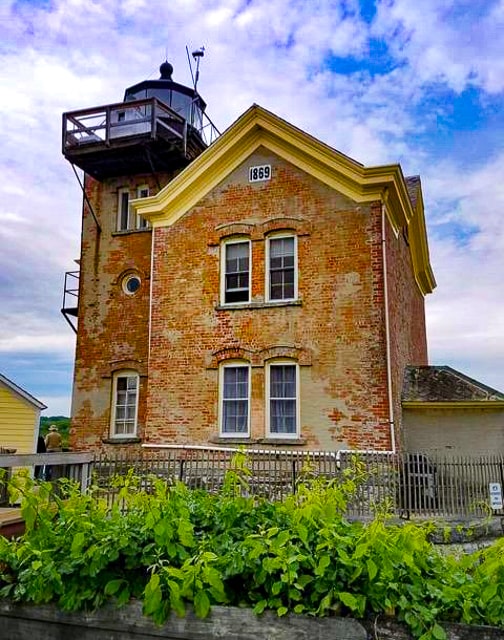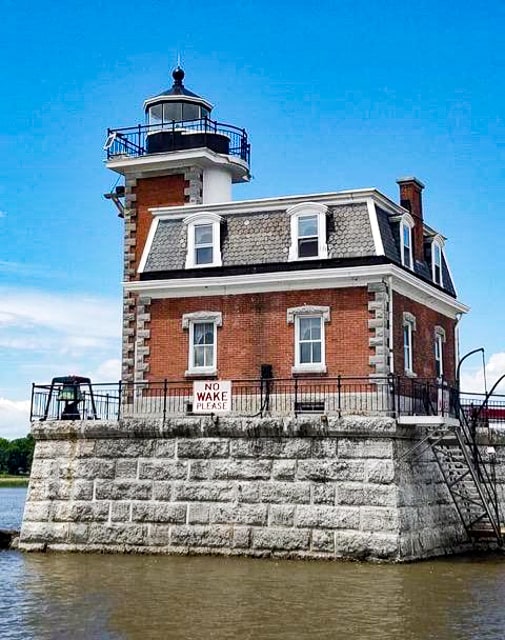At one time, there were 14 Hudson River Lighthouses. Today, seven remain.
Lighthouses are synonymous with crashing waves, sandy beaches, and soaring seagulls. Their flashing lights warn ships of dangers at sea. Beacons along the Hudson River serve an equally important function for guiding boats and ships from hazards in the rapid-moving waters.
The river surface appears calm and free-flowing. Underneath the never-ending streams can be immoveable sandbars, muddy flats, and jagged shoals, creating hazardous river travel conditions and impacting commerce and trade.
At one time, there were 14 lighthouses along the river. As time passed, many lighthouses fell into disrepair or were destroyed. Nowadays, there are seven remaining lighthouses that you can visit and learn about life along the Hudson River. The seven lighthouses dot the landscape stretching from upper Manhattan in the south to Hudson, New York in the north.
1 – Little Red
Our journey begins in upper Manhattan at Jeffrey’s Hook or The Little Red Lighthouse. Little Red sits underneath the George Washington Bridge in Fort Washington Park. It was made famous by the 1942 children’s book, The Little Red Lighthouse and the Great Gray Bridge by Hildegarde Swift. This 40-foot tall, conical-shaped lighthouse can be reached from roads and paths along the Hudson River Greenway located in the Washington Heights neighborhood.
2 – Tarrytown
Sailing 20-miles north, you arrive at the Tarrytown Lighthouse. It is also known as the Kingsland Point Light or Sleepy Hollow Light. It is the only lighthouse located in Westchester County and the only one on the lower Hudson with living quarters. This sparkplug lighthouse was erected in 1883 to warn ships away from the dangerous shoals extending between Tarrytown and Ossining’s towns. The lighthouse is accessible by a footpath in Kingsland Point County Park in the Village of Sleepy Hollow.
3 – Stony Point
As you head 25-miles further north, you arrive at Stony Point, New York, and Stony Point Lighthouse. Stony Point is the oldest lighthouse along the Hudson River. It was built in 1826 on the site where one of the last Revolutionary War battles took place.
A lightkeepers’ job was not easy, and women often assumed the keeper’s role if their husbands became ill or died. On one occasion during a dense fog, a lightkeeper, Nancy Rose, remained at her post for fifty-six hours, tolling the fog bell every thirty seconds. This octagonal-shaped lighthouse is on a hill surrounded by beautiful grounds with breath-taking views of the river.
There is also a historical museum on the property. Park staff is available to transport visitors from the parking lot to the main park area. Those interested in military history might consider a short drive north to the West Point Military Academy.
4 – Esopus Meadows
Our journey continues 52-miles to the town of Port Ewen, New York. The Esopus Meadows Lighthouse is fondly known as the Maid of the Meadows. The beacon was added to the National Register of Historic Places in 1979. It is the last wooden lighthouse on the Hudson River, erected in 1839 to warn ships of mudflats known as Esopus Meadows. This lighthouse is only accessible by boat with tours leaving from Kingston, New York. Kingston, New York, is located 91-miles north of New York City at the Catskill Mountains base on Rondout Creek. It was once the capital city of New York.
5 – Rondout II
The first Rondout Creek Lighthouse was erected in 1837 to warn mariners of shallow tidal flats at Rondout Creek’s mouth. The current lighthouse, known as Rondout II, is a two-and-one-half story yellow brick building and still operates as a navigational light. This lighthouse is only accessible by boat. Tours are available to Esopus Meadows and Rondout Lighthouse from the Hudson River Maritime Museum.
6 – Saugerties
As you head thirteen miles north, you arrive at the Saugerties Lighthouse. This lighthouse is a charming brick dwelling accessible by land or boat. It also functions as a bed and breakfast with a gift shop, parlor, and keepers’ quarters. There is a half-mile nature trail leading to the lighthouse from the parking area.
7 – Hudson-Athens
The Hudson-Athens Lighthouse, or Hudson City Light, is the northernmost lighthouse, built in 1874. It stands on a granite caisson in the river between the towns of Hudson and Athens. The lighthouse is made in the Second Empire style.
A prominent feature is the mansard roof. The mansard roof is a steep double-pitched roof with dormer windows. This architecture style was used on the Stepping Stones Lighthouse in Long Island Sound, built several years later.
Volunteers lead tours through the lighthouse. Visitors can watch Emily Brunner’s video describing her life at the lighthouse during the 1930s. Boats depart from Henry Hudson Riverfront Park in Hudson or Athens for a short ride to the lighthouse.
“Rivers are roads that move and carry us whither we wish to go.” – Blaise Pascal
About the Hudson River
The Hudson River is a 315-mile river originating in the Adirondack Mountains of upstate New York. It flows southward through the heart of New York State. The Hudson River’s mouth begins on the highest point in New York State at Mount Marcy. It flows to Upper New York Bay, eventually draining into the Atlantic Ocean at New York Harbor.
The river is named for the English explorer Henry Hudson. He sailed the river in 1609. The Hudson River is the eastern outlet for the Erie Canal and became an important transportation route in the early 19th century.
The Hudson Valley’s natural beauty served as the inspiration for 18th-century author Washington Irving and his classic tale, The Legend of Sleepy Hollow. Thomas Cole founded The Hudson River School of landscape painting during this period. You can visit the Thomas Cole Historic Site at 218 Spring Street, Catskill, New York.
Unfortunately, factories that sprung up along the riverbanks in the early 1900s almost destroyed the river. For many years factories dumped sewage and toxins into the river. The pollution created an unsafe environment for fish and wildlife. The ongoing efforts of local people led to the cleaning of the river and safeguards for the environment. The passage of federal, state, and local laws, and volunteer groups, gradually restored life to the Hudson River. Today the river is once again enjoyed by boaters, anglers, and even swimmers.
There are many ways to explore the river, whether by car, train, or hiking trails. One of the best ways to experience the towns along the Hudson River is by boat. As the New York area is subject to seasonal weather conditions, daily boat trips are generally available from May to October. While enjoying a relaxing float trip on the river, you get to view well-preserved lighthouses that serve as aids to navigation.
The lighthouses of the Hudson River are guideposts to the past, present, and future. They remind visitors of the river’s historical importance and the need to nurture and preserve it for future generations.
About Marianne Casey—Marianne is a native New Yorker, Brooklyn born and bred, and a retired educator. She is a freelance travel writer and photographer who enjoys all types of travel and exploring new places. She has sailed on 20 cruises and especially prefers themed sailings. She is a lighthouse enthusiast interested in the history and preservation of these monuments. Casey has traveled the United States, Canada, the Caribbean, and Europe. Marianne is looking forward to seeing Europe in the future, along with her favorite island destinations of Bermuda and Aruba. Marianne is a member of the ITWPA and Travel Writers Café. Follow her on Facebook, Instagram, and Twitter.

